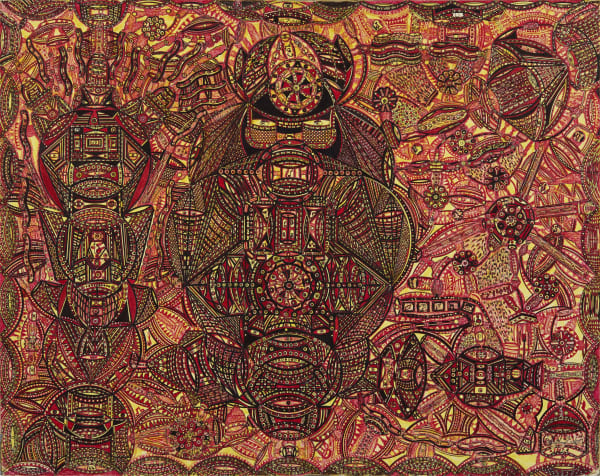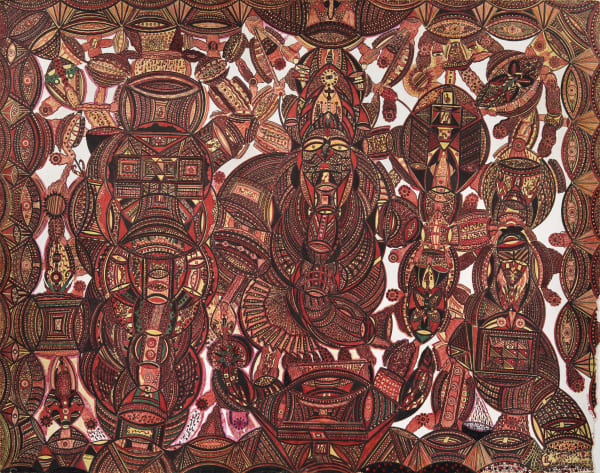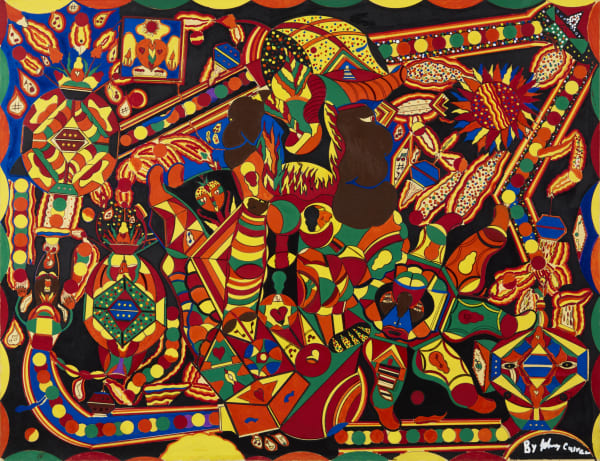For self-taught artist Johnny Culver, it is difficult to find the words to describe his work. That might be because the words don’t exist yet. After stumbling upon his art practice during a deep depression, Culver discovered not only an artistic talent but a method for interacting with a realm beyond our own. Though his works appear objectively abstract, bringing to mind the intricate patterning of a Persian rug or the colorful psychedelia of a kaleidoscope, Culver believes they contain messages from the future, and depict a life after death.
Born and raised in Sparta, Georgia in 1960, Culver did not grow up with the beliefs he carries today. He spent his early life living on a plantation outside of Sparta, with his mother, grandmother, twin brother Donny, and three younger siblings. He fondly remembers spending time with his grandmother, watching her sew quilts, weave baskets, and make beauty products out of materials from the swamp. He often asked her where she got the inspiration for these creations, to which she would reply, “I just put it all together.” At the time, Culver didn’t realize his grandmother’s intuitive creativity would later influence his own artistic practice.
Photograph of the artist by Fred Scruton
-
At seven years old, Culver was diagnosed with Blount’s disease, a condition characterized by bowed legs, short stature, and often linked to early weight-bearing or walking. He spent his early school years with a set of leg braces, and by the time he reached eleventh grade, was admitted to a rehabilitation center for handicapped adults in the nearby town of Milledgeville. After a year, he relocated to a related facility in Augusta and received training to be a commercial chef. Through this new facility, Culver found housing in Atlanta, Georgia, started working as a cafeteria chef, and began a stable life in the new city. However, this stability was quickly upturned when Culver fell in love with a woman who ultimately ended their relationship and sent Culver into a mental breakdown. He moved back in with his mother, got a job pumping gas at a local fishing supply store, and eventually started to draw—which Culver credits with saving his life and introducing him to the spirituality that guides him today.
-
One day, Culver picked up a piece of cardboard and started drawing geometric patterns on it. He quickly discovered that the practice brought him a sense of peace and started drawing on whatever materials he could find. As Culver moved on to larger sheets of paper, creating ambitiously intricate webs of color, he began to discover a more mystical purpose behind the practice. Suddenly, certain shapes became time gates, while others turned into ships that could pass through them. He recognized some symbols as plants, and others as small sentient “micronauts.” As Culver continued to draw, he began to understand his work as a depiction of a surrealist realm—a paradise beyond Earth, timeline, and life he knew. Today, in his early 60s, Culver works as a butcher at a local grocery store in Sparta and continues to draw every day. He typically begins with a large sheet of paper and a black pen, with which he creates his webs of imagery, starting at the center of the page and working his way out, adding color when applicable. For Culver, each work is another step towards understanding the realm from which he creates. “It tells me what’s next,” Culver says of his practice “the more I draw, the more it reveals itself.”
-
The longer you look at a Culver work, the more you’ll find. Initially, his drawings appear almost mathematically rendered. They are not too busy or overwhelming. Their patterns project a certain absoluteness as if they’ve been perfected over generations. However, further examination reveals stranger details, such as musical notes, mysterious symbols, hearts, flames, and faces. And while the works appear to obey the rules of geometry, they’re asymmetrical, and incredibly diverse in their patterning. Cosmic paths begin on one side of the work and wind into spirals. A thick line dissolves into a patterned flower or sea of colored tiles. Each drawing is surrounded by a highly detailed border, But the details are unpredictable—diamonds morph into dots, then into negative space, and finally into thin bars of color. For Culver, all these subtleties are essential, they act as portals through which messages can travel, floral machines that purify the environment, and maintenance men that keep everything intact. The future they predict is one of security, enchantment, and vivid color.
— Text by Chloe Kohlhoss
SOURCES
*Stavroula Coulianidis's interview with Johnny Culver
*Patterson, Tom. “Johnny Culver: Time Traveller Seeks Paradise.” Raw Vision #81. Spring, 2014.








